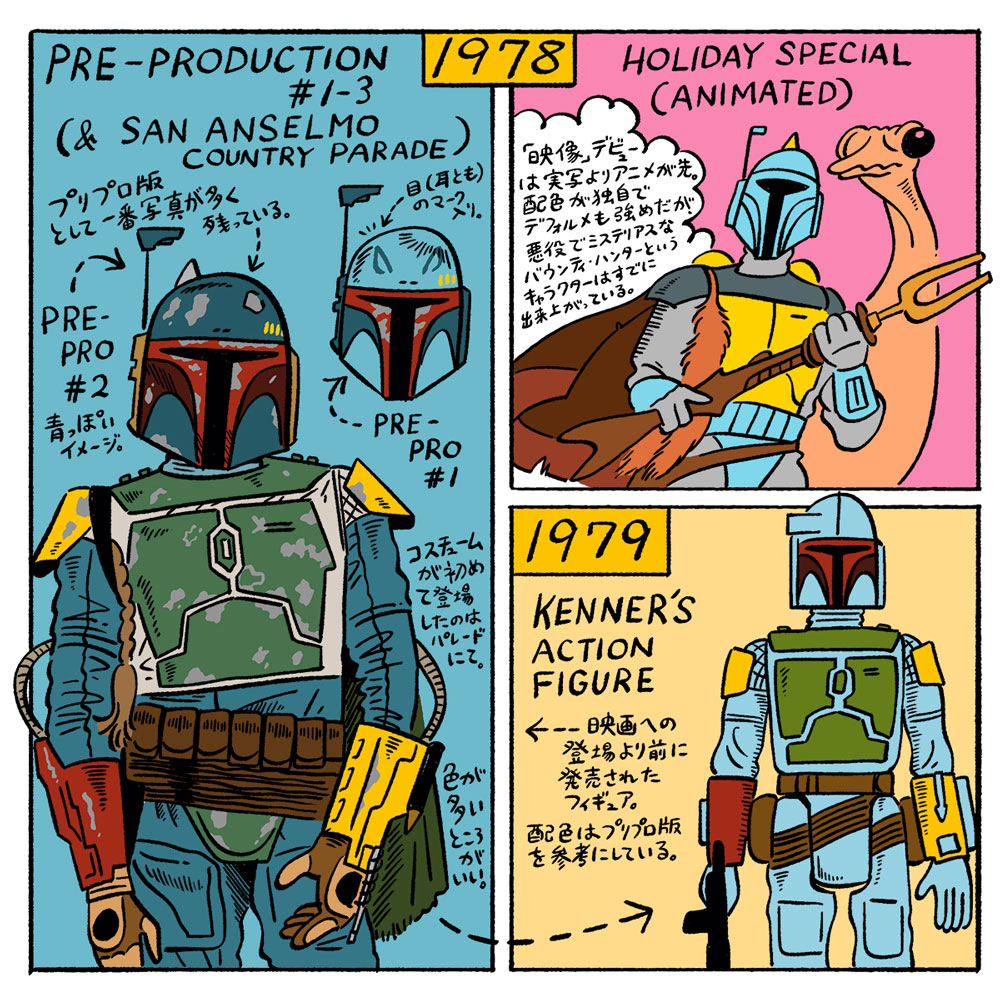A bounty hunter who appeared before the movie.

Paint something white. This may seem simple, but it seems like it was a lot of trial and error. In fact, the options were probably wide-ranging because the starting point was white. Johnston and his assistant Sandy Dewfetter ended up painting six helmets in total, all with slightly different hues. Costumes in the prototype stage are called pre-production versions (pre-production version), and will be completed through three stages, but the first costume, the Pri-production 1 costume, will be unveiled to the public as soon as possible. become. In September 1978, California appeared as a mysterious new character at the San Anselmo Country Fair Parade.
The way he walks next to Darth Vader suggests that this character's position and role have already been determined. This was the first time Boba Fett appeared in public. It was a very hot day, and Dwayne Dunham, who worked as a film editor at Lucasfilm, was sweating in a costume that no one knew. A distinctive feature of the pre-production version's costume is that the coloring is slightly different from the appearance seen in the movie, but the main point of the pre-production version of the helmet is that it has a mark called "eye" (also known as "ear") on the forehead. .
In November of the same year, the TV special ``Holiday Special'' was broadcast, and while the main cast including Mark Hamill, Carrie Fisher, and Harrison Ford appeared, Boba Fett appeared in an animated part inserted in between. , this was his first appearance on film. When he appears, he appears to be a mysterious figure who will help the heroes, but he actually has a connection with Darth Vader... This is a small introduction in preparation for his appearance in The Empire Strikes Back . It looks like this. It's an anime with quite interesting designs, and Boba's colors are different from the movie and the pre-production version, but according to John Celestetri, the animator in charge, he looks like the French artist Jean Giraud, also known by Lucas as Moebius. Apparently, he was asked to create a unique style, and Boba's light blue and yellow colors were inspired by Moebius's color scheme. It certainly has that kind of atmosphere, with the shadow lines drawn on the characters' bodies and the pink color of the planet's surface. Considering that the costumes were also exploring colors around the same time, the anime probably needed to start with the white version and consider its own color scheme. 1978 seems to have been a very hectic, dense, and important year in Boba Fett's history.
Through the parade and animation, the new characters became known to people. Thus, in 1979, a Boba Fett action figure was released by Kenner, which handles all toys in the series. The coloring of this figure is also unique, but since it was created based on the pre-production version mentioned above, the color scheme is based on blue, and the gauntlets are yellow and red on the left and right sides of the body. I like the pre-pro version with many colors, but this figure is very cute, thanks to the toy-like feel of early Kenner figures.
The pre-production version has also progressed to the third type of painting, and although there are still differences in things like gauntlets, the helmet is much closer to "The Empire Strikes Back." By the way, PriPro 2 has the most photos left, and you can see that it has progressed to the point of producing solid still photos. Looking at these prototypes, you can feel Johnston and his team's dedication to painting. Not only the color but also the dirt, scratches, and peeling that characterize Boba must have been applied repeatedly. Duifetter, who worked with Johnston on the production, paid attention not only to the painting but also to the accessories. According to an interview with Boba Fett Fan Club, they used accessories such as belts and tarpaulins collected at military stores to make the costumes more realistic. (It was previously thought that it was the fur of a killed Wookiee) is said to be the hair of a horse's tail that she had obtained and knitted.
In this way, the strongest bounty hunter's costume was created in many different ways in a short period of time, and the attention to detail made it possible to achieve that bizarre pose.

![The history of bounty hunter Boba Fett [Mizumaru Kawahara's CINEMONOLOGUE Vol.50]](https://cinemore.jp/images/ca72abc9174f2649278c1d046281d370b9fd3796558208d40a72fb23f53e3497.jpg)
